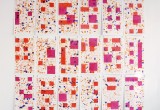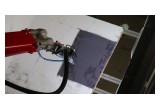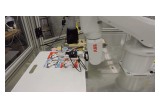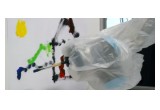Winners Announced in First-Annual $100,000 International Robot Art Competition

Seattle, Washington, May 16, 2016 (Newswire.com) - RobotArt.org announces the winners of its first annual $100,000 competition. The contest challenged artists and engineers to create a robot that painted with an artist’s brush. Teams from around the world responded to the challenge by submitted over seventy robot created paintings. The winning robots were determined based on a combination of public voting, professional judges, and how well the team met the spirit of the competition – that is, to create something beautiful using a brush and artificial intelligence. As official rankings were tallied, the winning teams were truly international with the top three teams residing in Asia, North America, and Europe.
First Place and $30,000 was awarded to TAIDA of Taiwan, a robotic arm that painted in a manner very similar to a classical painter. The team led by Ming-Jyun Hong of Taiwan National University, impressed judges with the fact that his robot used visual feedback to mix its own palette from a limited selection of cyan, magenta, yellow, black, and white paints. Once it achieved the desired color, it would begin by first laying down and underpainting before continuing on to a refinement layer. In the refinement layer the robot would repeatedly compare the picture drawn on the canvas with what it was attempting to paint to find the most different area, and then try to make it less different, similar to how a classical painter goes about completing a canvas.
The results of this competition show a significant step in the advancement of robotics and artificial intelligence to create beauty. In addition the being geographically diverse, the approach to creating art that these robots took varied significantly, sometimes in unexpected exciting ways. Some robots concentrated on mastering traditional painting techniques, others experimented with artificial creativity, while others explored the nature of human/robot collaboration. I am exciting to see how new teams take in this year's results, and try to top them in next year's competition.
Andrew Conru, RobotArt.org Founder
Second Place and $18,000 was awarded to cloudPainter of the United States. The most notable aspect of cloudPainter, the creation of the father-son team of Pindar and Hunter Van Arman, was its autonomy. Pindar and Hunter attempted to create a robot that was responsible for every aspect of the creative process. In two portraits that they submitted, their robot began by taking several photos of them, used its own aesthetic criteria to select its favorite photo, cropped the image into its own unique composition, and completed the painting one stroke at a time using feedback loops. Except for the decision to create a portrait, they programmed their robot to independently make each and every aesthetic decision from beginning to end.
Third Place and $12,000 was awarded to NoRAA of Italy. The artist behind NoRAA, Patrick Tabarelli, created the robot to explore the field in between algorithms and the physical world. While the first and second place robots concentrated on representational artwork, NoRAA’s work was abstract and extremely popular with the professional judges. Judges Patrick and Jeannie Wilshire noted that it was an example of “artwork produced BY a robot, rather than THROUGH a robot.”
The remainder of the $100,000 purse was split between twelve teams to acknowledge notable contributions and included visual feedback pioneers e-David, student lead RHIT, Picassnake, EyePaint, Simple But Significant, Guild of Robotic Artists, AI, artistBots, Pixobots, CM2, VIP, and Polar Printing Press.
RobotArt.org founder Andrew Conru notes that "The results of this competition show a significant step in the advancement of robotics and artificial intelligence to create beauty. In addition the being geographically diverse, the approach to creating art that these robots took varied significantly, sometimes in unexpected exciting ways. Some robots concentrated on mastering traditional painting techniques, others experimented with artificial creativity, while others explored the nature of human/robot collaboration. I am exciting to see how new teams take in this year’s results, and try to top them in next year’s competition.”
More details, quotes, pictures, and videos of the robots and their artwork can be seen in the official prize announcement at http://robotart.org.
Source: RobotArt.org







